Abstract
An LT-B-ST (LT-B/ST) fusion peptide was constructed by genetically joining the 5' terminus of a synthetic gene coding for the heat-stable enterotoxin (ST) of Escherichia coli to the 3' terminus of the gene coding for the binding subunit of the heat-labile enterotoxin (LT-B) of E. coli. An eight-amino-acid, proline-containing linker was included between the LT-B and ST moieties. An aroA mutant of Salmonella dublin transformed with a plasmid carrying this genetic construct was shown to express a fusion peptide with antigenic determinants of both LT-B and ST. Mice were immunized orally with this strain or with a control strain expressing just LT-B from the same plasmid. Sera and mucosal secretions were obtained and analyzed for the presence of serum immunoglobulin G and mucosal immunoglobulin A that were able to recognize LT-B and ST by enzyme-linked immunosorbent assay (ELISA) and, more importantly, were able to neutralize native ST in the suckling mouse assay. Sera and mucosal secretions from animals immunized with the strain expressing the LT-B/ST fusion exhibited detectable ELISA reactivity against LT-B but not against native ST. However, even in the absence of detectable ELISA reactivity, both sera and mucosal secretions from these animals were able to neutralize the biological activity of native ST in the suckling mouse assay. These findings are important because they demonstrate the development of mucosal protection against ST by oral immunization with a genetic fusion delivered by a bacterial vector.
Full text
PDF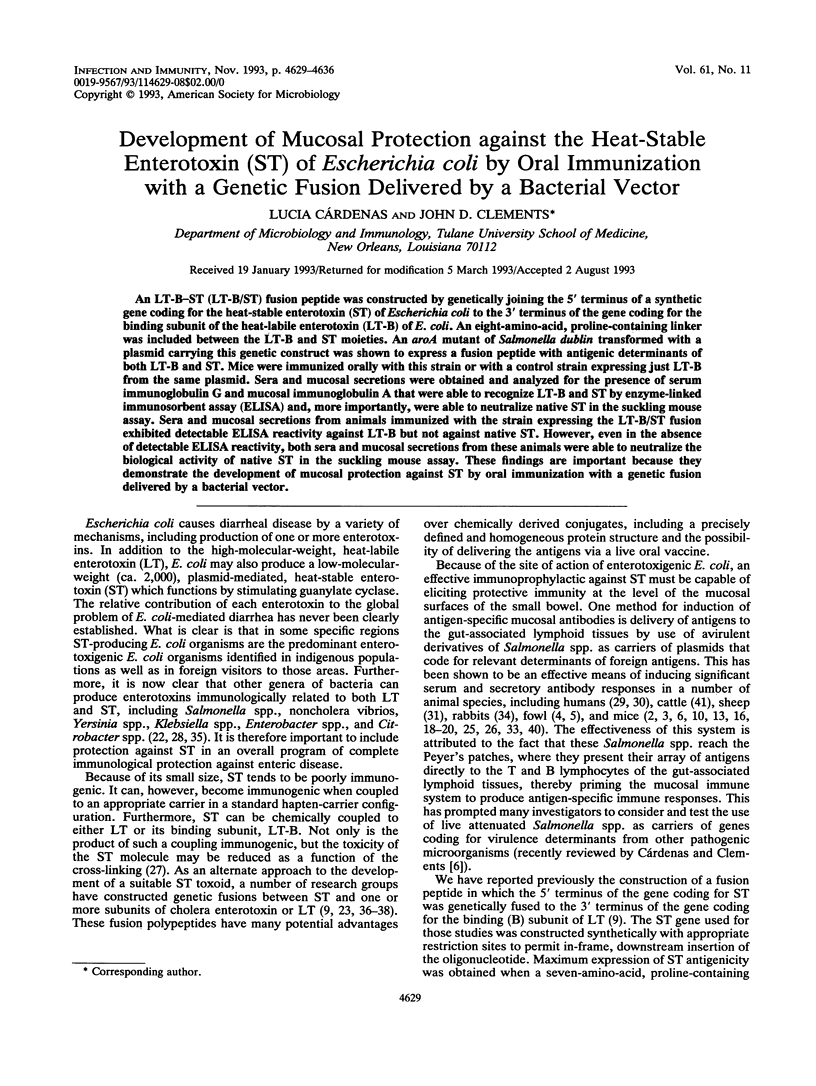
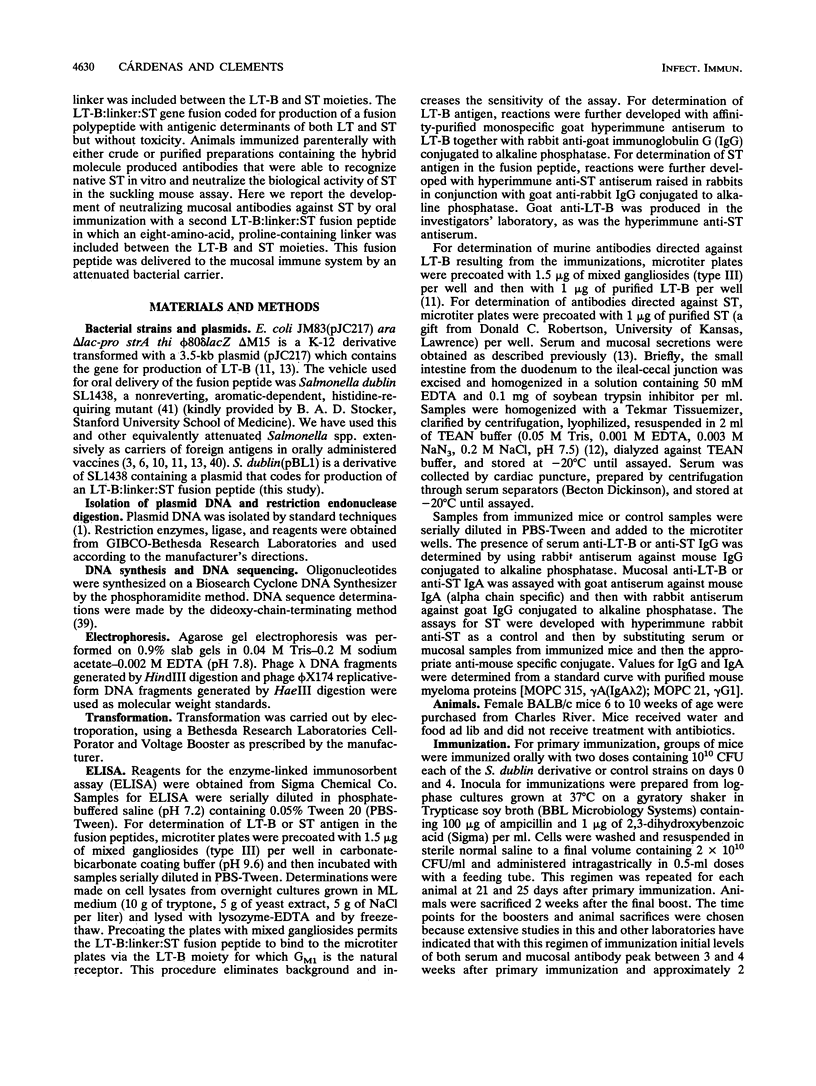
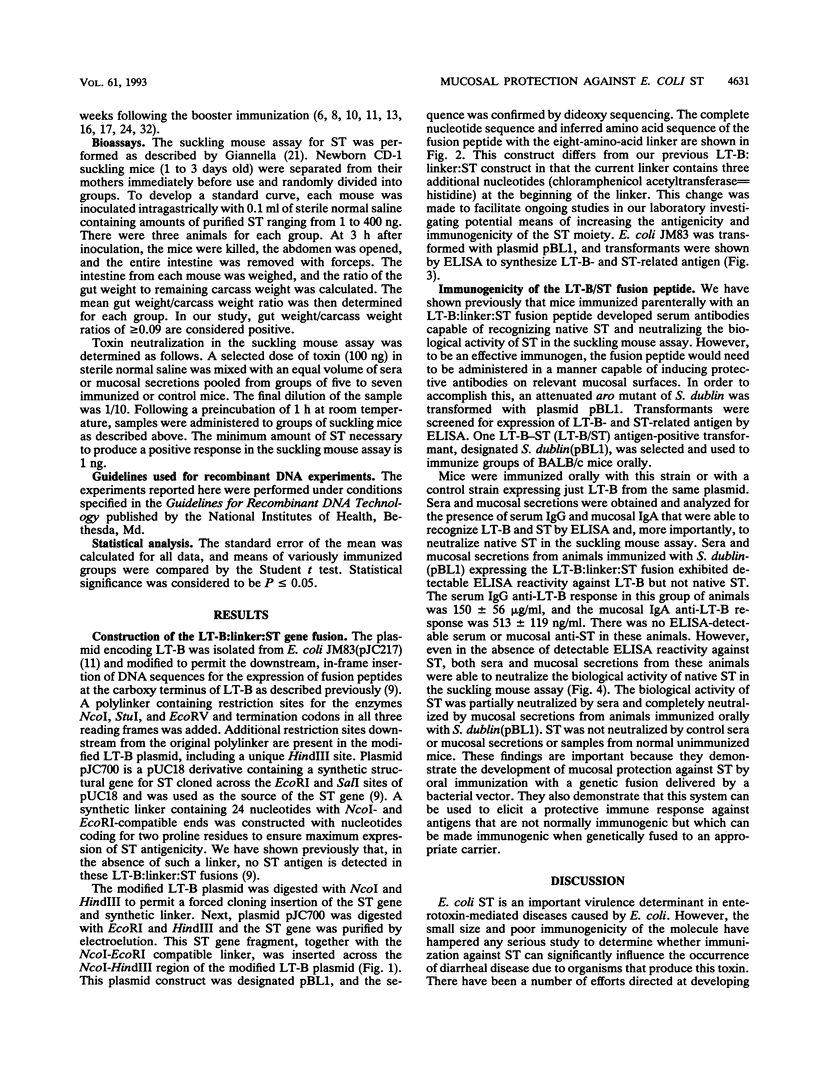
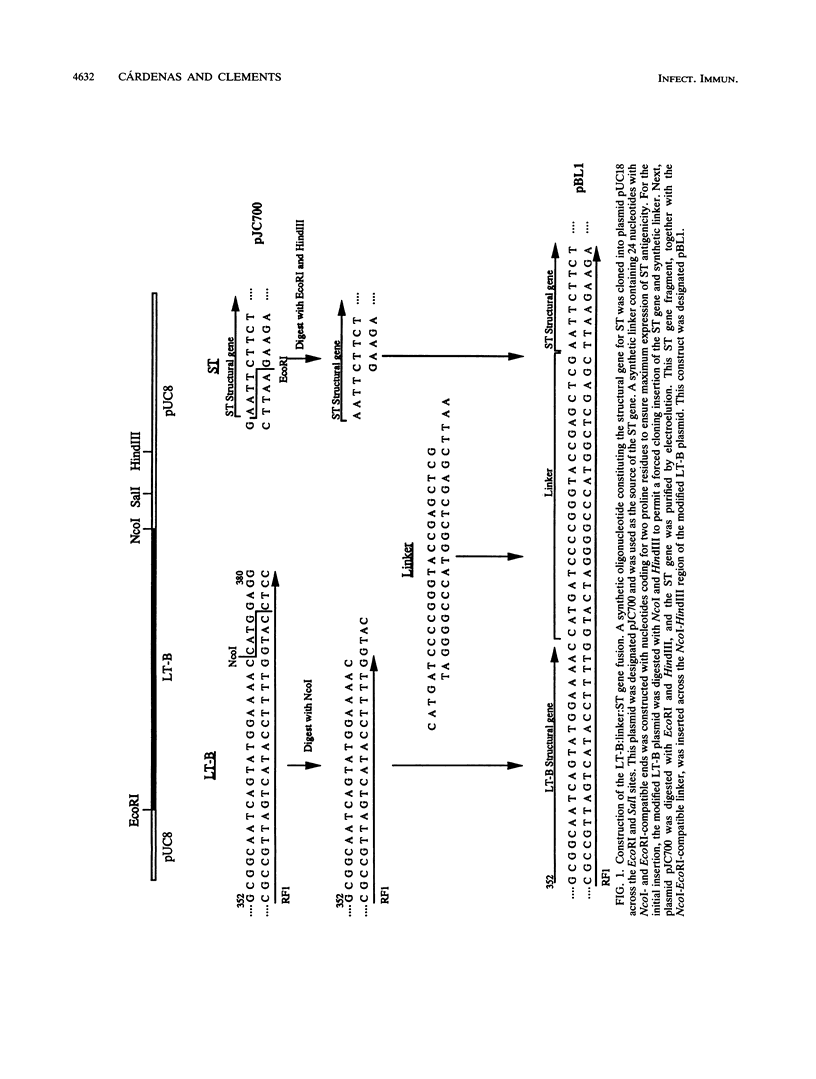
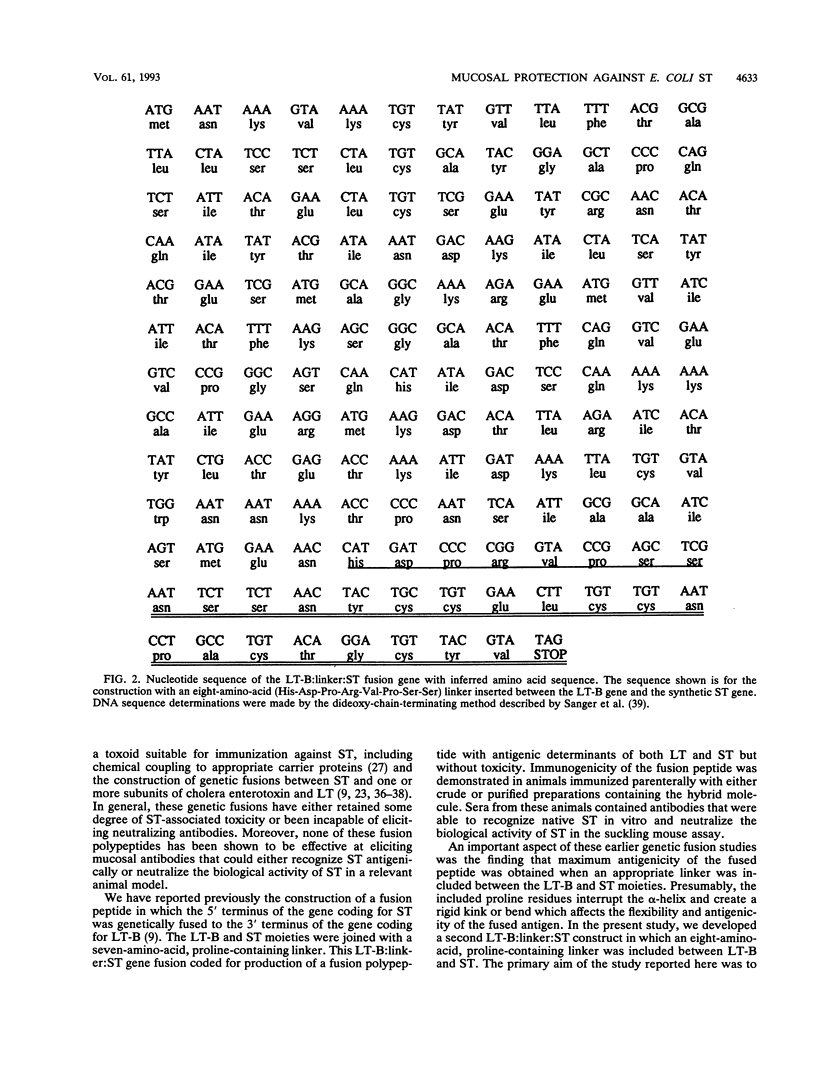
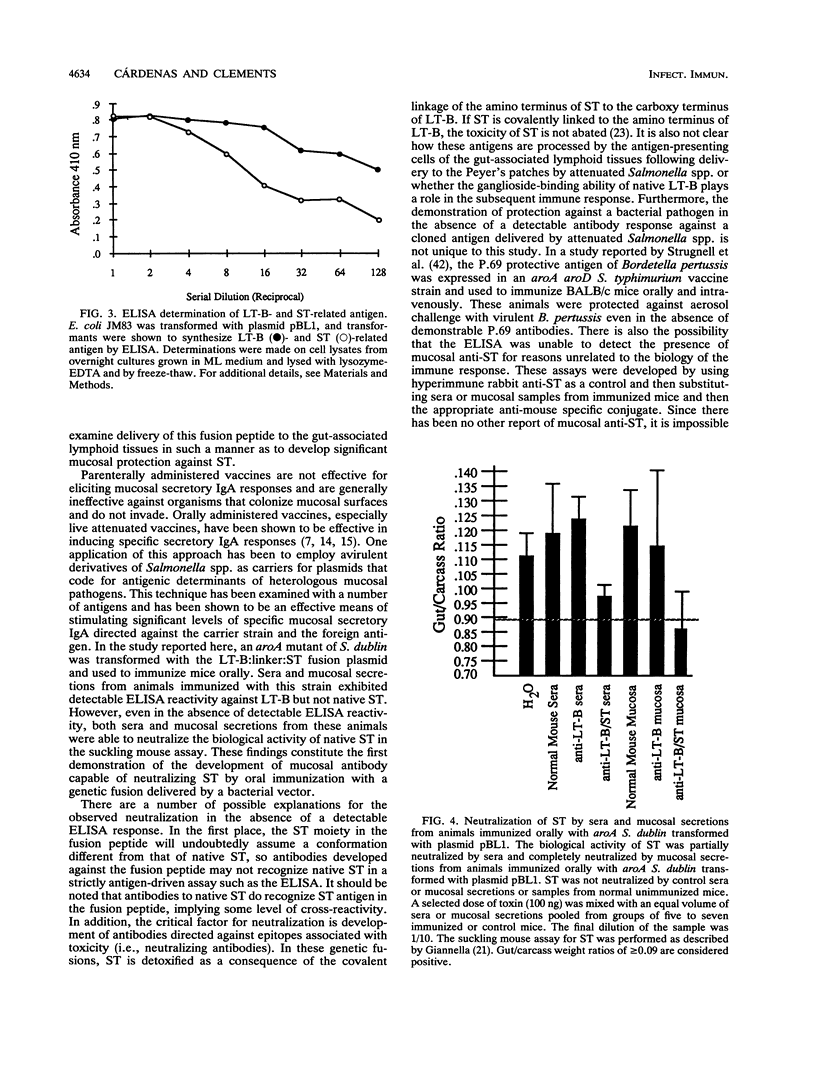
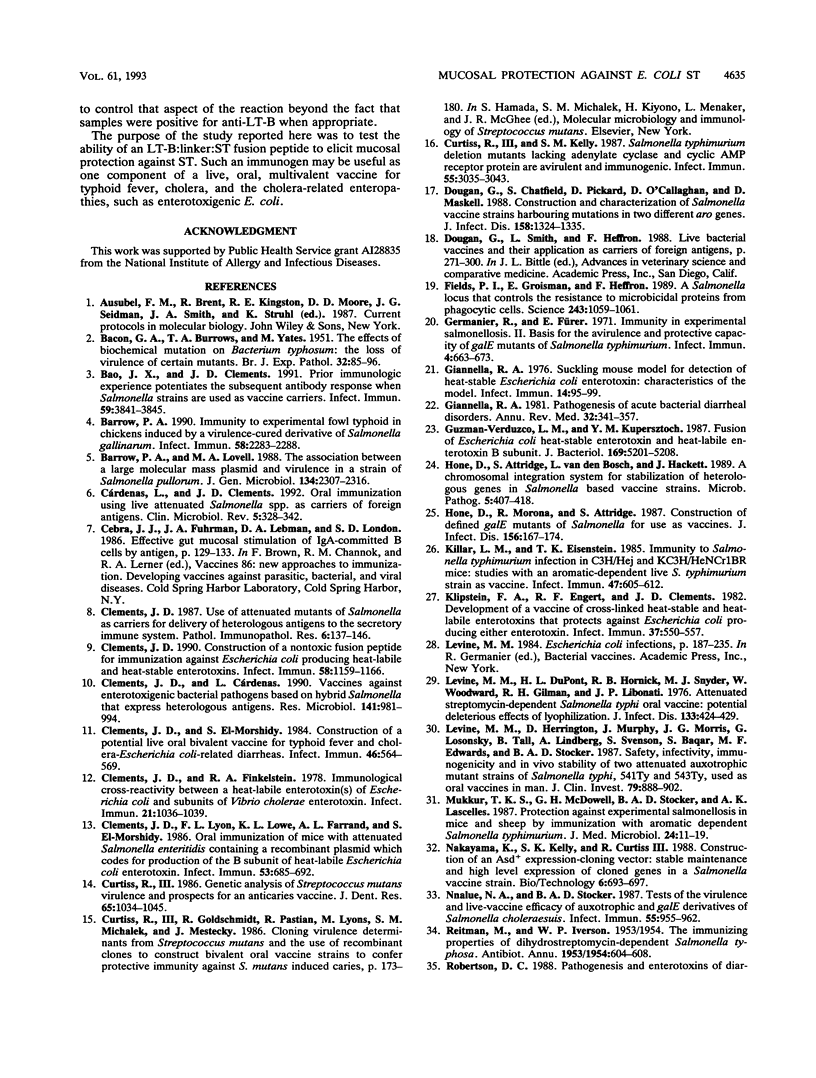
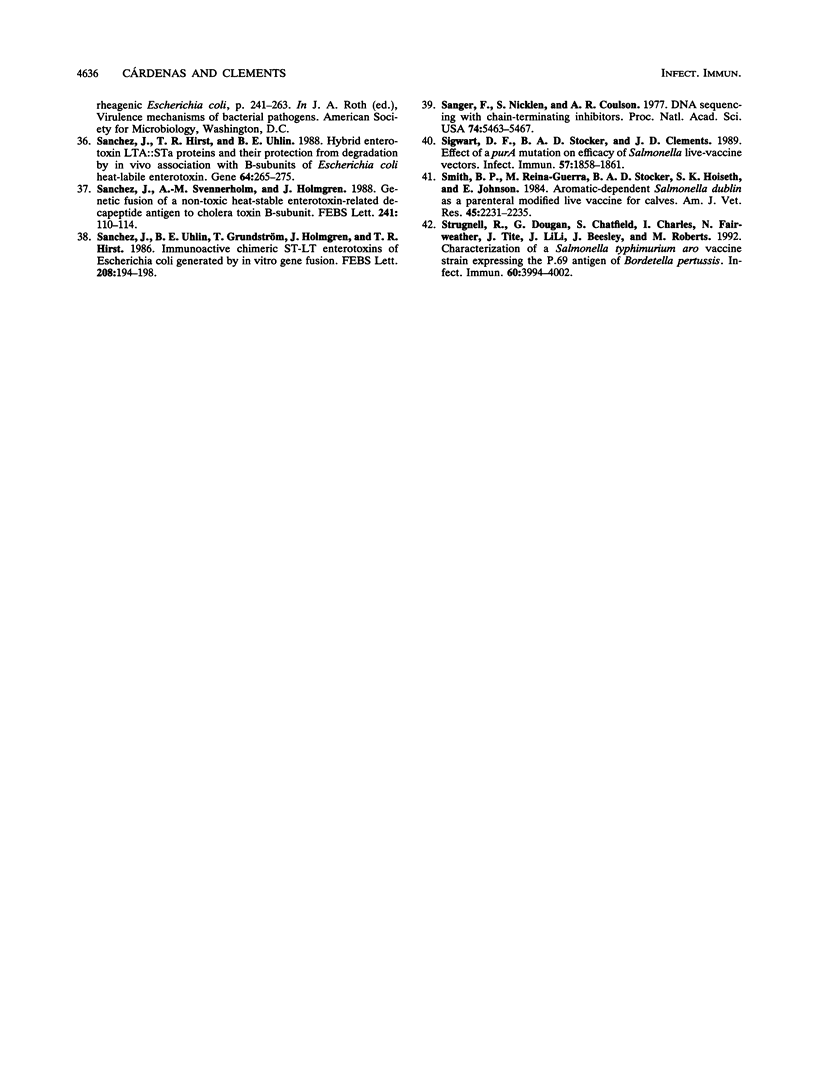
Selected References
These references are in PubMed. This may not be the complete list of references from this article.
- BACON G. A., BURROWS T. W., YATES M. The effects of biochemical mutation on the virulence of Bacterium typhosum; the loss of virulence of certain mutants. Br J Exp Pathol. 1951 Apr;32(2):85–96. [PMC free article] [PubMed] [Google Scholar]
- Bao J. X., Clements J. D. Prior immunologic experience potentiates the subsequent antibody response when Salmonella strains are used as vaccine carriers. Infect Immun. 1991 Oct;59(10):3841–3845. doi: 10.1128/iai.59.10.3841-3845.1991. [DOI] [PMC free article] [PubMed] [Google Scholar]
- Barrow P. A. Immunity to experimental fowl typhoid in chickens induced by a virulence plasmid-cured derivative of Salmonella gallinarum. Infect Immun. 1990 Jul;58(7):2283–2288. doi: 10.1128/iai.58.7.2283-2288.1990. [DOI] [PMC free article] [PubMed] [Google Scholar]
- Barrow P. A., Lovell M. A. The association between a large molecular mass plasmid and virulence in a strain of Salmonella pullorum. J Gen Microbiol. 1988 Aug;134(8):2307–2316. doi: 10.1099/00221287-134-8-2307. [DOI] [PubMed] [Google Scholar]
- Clements J. D. Construction of a nontoxic fusion peptide for immunization against Escherichia coli strains that produce heat-labile and heat-stable enterotoxins. Infect Immun. 1990 May;58(5):1159–1166. doi: 10.1128/iai.58.5.1159-1166.1990. [DOI] [PMC free article] [PubMed] [Google Scholar]
- Clements J. D., Cárdenas L. Vaccines against enterotoxigenic bacterial pathogens based on hybrid Salmonella that express heterologous antigens. Res Microbiol. 1990 Sep-Oct;141(7-8):981–993. doi: 10.1016/0923-2508(90)90138-g. [DOI] [PubMed] [Google Scholar]
- Clements J. D., El-Morshidy S. Construction of a potential live oral bivalent vaccine for typhoid fever and cholera-Escherichia coli-related diarrheas. Infect Immun. 1984 Nov;46(2):564–569. doi: 10.1128/iai.46.2.564-569.1984. [DOI] [PMC free article] [PubMed] [Google Scholar]
- Clements J. D., Finkelstein R. A. Immunological cross-reactivity between a heat-labile enterotoxin(s) of Escherichia coli and subunits of Vibrio cholerae enterotoxin. Infect Immun. 1978 Sep;21(3):1036–1039. doi: 10.1128/iai.21.3.1036-1039.1978. [DOI] [PMC free article] [PubMed] [Google Scholar]
- Clements J. D., Lyon F. L., Lowe K. L., Farrand A. L., el-Morshidy S. Oral immunization of mice with attenuated Salmonella enteritidis containing a recombinant plasmid which codes for production of the B subunit of heat-labile Escherichia coli enterotoxin. Infect Immun. 1986 Sep;53(3):685–692. doi: 10.1128/iai.53.3.685-692.1986. [DOI] [PMC free article] [PubMed] [Google Scholar]
- Clements J. D. Use of attenuated mutants of Salmonella as carriers for delivery of heterologous antigens to the secretory immune system. Pathol Immunopathol Res. 1987;6(2):137–146. doi: 10.1159/000157055. [DOI] [PubMed] [Google Scholar]
- Curtiss R., 3rd 1984 Kreshover lecture. Genetic analysis of Streptococcus mutans virulence and prospects for an anticaries vaccine. J Dent Res. 1986 Aug;65(8):1034–1045. doi: 10.1177/00220345860650080101. [DOI] [PubMed] [Google Scholar]
- Curtiss R., 3rd, Kelly S. M. Salmonella typhimurium deletion mutants lacking adenylate cyclase and cyclic AMP receptor protein are avirulent and immunogenic. Infect Immun. 1987 Dec;55(12):3035–3043. doi: 10.1128/iai.55.12.3035-3043.1987. [DOI] [PMC free article] [PubMed] [Google Scholar]
- Cárdenas L., Clements J. D. Oral immunization using live attenuated Salmonella spp. as carriers of foreign antigens. Clin Microbiol Rev. 1992 Jul;5(3):328–342. doi: 10.1128/cmr.5.3.328. [DOI] [PMC free article] [PubMed] [Google Scholar]
- Dougan G., Chatfield S., Pickard D., Bester J., O'Callaghan D., Maskell D. Construction and characterization of vaccine strains of Salmonella harboring mutations in two different aro genes. J Infect Dis. 1988 Dec;158(6):1329–1335. doi: 10.1093/infdis/158.6.1329. [DOI] [PubMed] [Google Scholar]
- Fields P. I., Groisman E. A., Heffron F. A Salmonella locus that controls resistance to microbicidal proteins from phagocytic cells. Science. 1989 Feb 24;243(4894 Pt 1):1059–1062. doi: 10.1126/science.2646710. [DOI] [PubMed] [Google Scholar]
- Germanier R., Fürer E. Immunity in experimental salmonellosis. II. Basis for the avirulence and protective capacity of gal E mutants of Salmonella typhimurium. Infect Immun. 1971 Dec;4(6):663–673. doi: 10.1128/iai.4.6.663-673.1971. [DOI] [PMC free article] [PubMed] [Google Scholar]
- Giannella R. A. Pathogenesis of acute bacterial diarrheal disorders. Annu Rev Med. 1981;32:341–357. doi: 10.1146/annurev.me.32.020181.002013. [DOI] [PubMed] [Google Scholar]
- Giannella R. A. Suckling mouse model for detection of heat-stable Escherichia coli enterotoxin: characteristics of the model. Infect Immun. 1976 Jul;14(1):95–99. doi: 10.1128/iai.14.1.95-99.1976. [DOI] [PMC free article] [PubMed] [Google Scholar]
- Guzman-Verduzco L. M., Kupersztoch Y. M. Fusion of Escherichia coli heat-stable enterotoxin and heat-labile enterotoxin B subunit. J Bacteriol. 1987 Nov;169(11):5201–5208. doi: 10.1128/jb.169.11.5201-5208.1987. [DOI] [PMC free article] [PubMed] [Google Scholar]
- Hone D., Attridge S., van den Bosch L., Hackett J. A chromosomal integration system for stabilization of heterologous genes in Salmonella based vaccine strains. Microb Pathog. 1988 Dec;5(6):407–418. doi: 10.1016/0882-4010(88)90002-2. [DOI] [PubMed] [Google Scholar]
- Hone D., Morona R., Attridge S., Hackett J. Construction of defined galE mutants of Salmonella for use as vaccines. J Infect Dis. 1987 Jul;156(1):167–174. doi: 10.1093/infdis/156.1.167. [DOI] [PubMed] [Google Scholar]
- Killar L. M., Eisenstein T. K. Immunity to Salmonella typhimurium infection in C3H/HeJ and C3H/HeNCrlBR mice: studies with an aromatic-dependent live S. typhimurium strain as a vaccine. Infect Immun. 1985 Mar;47(3):605–612. doi: 10.1128/iai.47.3.605-612.1985. [DOI] [PMC free article] [PubMed] [Google Scholar]
- Klipstein F. A., Engert R. F., Clements J. D. Development of a vaccine of cross-linked heat-stable and heat-labile enterotoxins that protects against Escherichia coli producing either enterotoxin. Infect Immun. 1982 Aug;37(2):550–557. doi: 10.1128/iai.37.2.550-557.1982. [DOI] [PMC free article] [PubMed] [Google Scholar]
- Levine M. M., DuPont H. L., Hornick R. B., Snyder M. J., Woodward W., Gilman R. H., Libonati J. P. Attenuated, streptomycin-dependent Salmonella typhi oral vaccine: potential deleterious effects of lyophilization. J Infect Dis. 1976 Apr;133(4):424–429. doi: 10.1093/infdis/133.4.424. [DOI] [PubMed] [Google Scholar]
- Levine M. M., Herrington D., Murphy J. R., Morris J. G., Losonsky G., Tall B., Lindberg A. A., Svenson S., Baqar S., Edwards M. F. Safety, infectivity, immunogenicity, and in vivo stability of two attenuated auxotrophic mutant strains of Salmonella typhi, 541Ty and 543Ty, as live oral vaccines in humans. J Clin Invest. 1987 Mar;79(3):888–902. doi: 10.1172/JCI112899. [DOI] [PMC free article] [PubMed] [Google Scholar]
- Mukkur T. K., McDowell G. H., Stocker B. A., Lascelles A. K. Protection against experimental salmonellosis in mice and sheep by immunisation with aromatic-dependent Salmonella typhimurium. J Med Microbiol. 1987 Aug;24(1):11–19. doi: 10.1099/00222615-24-1-11. [DOI] [PubMed] [Google Scholar]
- Nnalue N. A., Stocker B. A. Test of the virulence and live-vaccine efficacy of auxotrophic and galE derivatives of Salmonella choleraesuis. Infect Immun. 1987 Apr;55(4):955–962. doi: 10.1128/iai.55.4.955-962.1987. [DOI] [PMC free article] [PubMed] [Google Scholar]
- Sanchez J., Hirst T. R., Uhlin B. E. Hybrid enterotoxin LTA::STa proteins and their protection from degradation by in vivo association with B-subunits of Escherichia coli heat-labile enterotoxin. Gene. 1988 Apr 29;64(2):265–275. doi: 10.1016/0378-1119(88)90341-1. [DOI] [PubMed] [Google Scholar]
- Sanchez J., Svennerholm A. M., Holmgren J. Genetic fusion of a non-toxic heat-stable enterotoxin-related decapeptide antigen to cholera toxin B-subunit. FEBS Lett. 1988 Dec 5;241(1-2):110–114. doi: 10.1016/0014-5793(88)81041-x. [DOI] [PubMed] [Google Scholar]
- Sanchez J., Uhlin B. E., Grundström T., Holmgren J., Hirst T. R. Immunoactive chimeric ST-LT enterotoxins of Escherichia coli generated by in vitro gene fusion. FEBS Lett. 1986 Nov 24;208(2):194–198. doi: 10.1016/0014-5793(86)81016-x. [DOI] [PubMed] [Google Scholar]
- Sanger F., Nicklen S., Coulson A. R. DNA sequencing with chain-terminating inhibitors. Proc Natl Acad Sci U S A. 1977 Dec;74(12):5463–5467. doi: 10.1073/pnas.74.12.5463. [DOI] [PMC free article] [PubMed] [Google Scholar]
- Sigwart D. F., Stocker B. A., Clements J. D. Effect of a purA mutation on efficacy of Salmonella live-vaccine vectors. Infect Immun. 1989 Jun;57(6):1858–1861. doi: 10.1128/iai.57.6.1858-1861.1989. [DOI] [PMC free article] [PubMed] [Google Scholar]
- Smith B. P., Reina-Guerra M., Stocker B. A., Hoiseth S. K., Johnson E. Aromatic-dependent Salmonella dublin as a parenteral modified live vaccine for calves. Am J Vet Res. 1984 Nov;45(11):2231–2235. [PubMed] [Google Scholar]
- Strugnell R., Dougan G., Chatfield S., Charles I., Fairweather N., Tite J., Li J. L., Beesley J., Roberts M. Characterization of a Salmonella typhimurium aro vaccine strain expressing the P.69 antigen of Bordetella pertussis. Infect Immun. 1992 Oct;60(10):3994–4002. doi: 10.1128/iai.60.10.3994-4002.1992. [DOI] [PMC free article] [PubMed] [Google Scholar]


